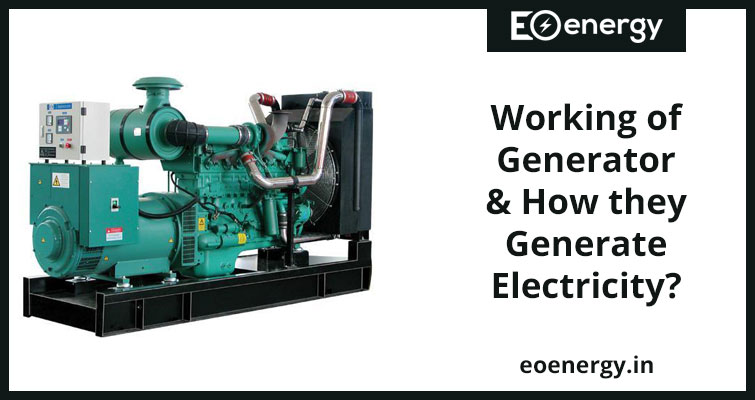An electric generator is a machine or device that converts mechanical energy into electrical energy. Mechanical energy sources are steam turbines, gas turbines, water turbines, wind turbines, internal combustion engines, and even hand cranks.
If you are interested to know about the working of the generator, then you are in the right place. To know more about the generator read the complete blog.
This is a useful appliance that supplies electricity when the electricity went and prevents discontinuity or disruption of business operations.
A portable generator is available in the market with different electrical and physical configurations for different uses. Some generator is small in size and portable. That is used for providing small amounts of power for a few devices. Furthermore, some generators required permanent installation for the entire house and industrial purpose.
There are diesel generators, gas generators, propane generators, and bi-fuel generators available in the markets.
Did you know what is the first electromagnetic Generator? The Faraday disk is the first generator. And it has been invented in 1831 in British. And the inventor of this is Michael Faraday.
Working of Generator
It is important to know that a generator does not create electrical energy. Instead, it uses mechanical energy and converts it into electrical energy with the help of an electric charge present in its windings.
Once the electricity generates. It directly supplies through the copper wires to the external devices or External machines.
A fixed amount of energy present in the world. Did you know about the conservation of energy? or how the generator produces electricity. Conservation of energy states that energy is neither be create and neither will be destroyed. It only converts from one form of energy to another form of energy.
Mainly, a generator is an electrical motor work in reverse conservation. A motor and a generator have many similarities.
When we provide electricity in a motor then what happens it start rotating. As well it’s reversed when you rotate a motor at a defined speed. With the help of external energy like steam, coal, gas, oil, etc, it starts generating electricity.
Today’s generators working are based on the principle of electromagnetic induction which is discovered by Michael Faraday in 1831.
Faraday discovered that when a conductor moves in the presence of a magnetic field. That means in the presence of both the north pole and south pole of a magnet. Than electrical charges produce and create a flow of current.
In the simple word and most basic, an electrical generator is nothing more than an electromagnet. Means moving wire near a magnet to cut the magnetic field. And to direct the flow of electrons in the form of electricity. It’s similar to like a motor pump, how a pump pushes water through a pipeline.
Faradays Law
The faradays law says that when a conductor places in the different magnetic fields (N, S), the EMF is induced. And this induced EMF is equal to the rate of change of flux linkages. Due to this, the EMF will be converted. When there is either a relative space or a relative time variation between the conductor and the magnetic field (N, S).
So the important elements of a generator are the magnetic field. And the motion of the conductor in the magnetic field.
Faradays Right-hand Rule
This law states that if you stretch your right-hand thumb. And the first finger and second finger perpendicular to each other. And place your right-hand thumb to the direction of the motion of the conductor magnetic field. The first finger shows the direction to the magnetic field then your second finger shows the direction of the EMF ( Electromotive Force) converted in the conductor.
There are two types of generators: –
- DC generators
- AC generators
Both DC and AC generators convert mechanical energy into electrical energy. A DC generator produces direct power or direct current. moreover, an AC generator produces alternating power or alternating current.
Direct current is the current that cannot change its value according to the time. Its value will be fixed and all the electronic devices or components are work on DC.
Alternative current is the current that changes its value according to time. Its value will be varying and all the electrical components or devices are work on the AC. Sometimes also we felt why an electrical generator won’t produce electricity. To rectify this issue you need to check & follow some important instructions.
Working Principle of Generator
Let us connect the slip ring with both ends of the loop conductor. We can also connect a load with the loop conductor through the brushes rest on the slip rings as shown in the figure. In this case, the alternating electricity converted in the loop comes the load. This is an example of an AC electric generator. This is the main concept of the working of a portable generator for home.
Working of DC Generator
We can also collect the electricity converted in the rotating loop conductor through commutator and brush arrangement as shown in the picture. In this case, the electricity convert in the loop (here the rotating loop of the single conductor loop generator can also be referred to as the armature) gets rectified through the commutator and the load gets a DC current. This is the basic concept of a DC generator.
Conclusion
In this article, we discuss how electricity generates with the help of a generator. We also discussed the AC and DC Generators. One intrusting thing, that energy can neither be created and nor be destroyed. It only converts from one form of energy to another form of energy.
I hope you understand how electricity will be converted or generated with the help of the generator. If you have any queries, comment below in the comment section.

